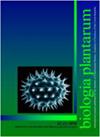Identification of key genes related to flowering by transcriptome of flowering and nonflowering Prunella vulgaris
IF 0.9
4区 生物学
Q4 PLANT SCIENCES
引用次数: 1
Abstract
Prunella vulgaris L. is known as ‘Xiaku-cao’, because it withers and dies after the summer solstice (Chen et al. 2013). It is a perennial herb in the family Lamiaceae, and its dried spicas are used in medicine (Liao et al. 2012). The Pharmacopoeia of the People’s Republic of China (2020) states that P. vulgaris has drug efficacy in removing liver-fire for improving eyesight, subsiding swelling to dissipate indurated mass. Modern research shows that P. vulgaris contains a variety of chemical constituents, such as phenylpropanoids, flavonoids, triterpenes, organic acids, sugars, coumarins, and steroids (Bai et al. 2016). Studies show that P. vulgaris exerts antitumour (Feng et al. 2010), anti-inflammatory (Hwang et al. 2013), and hypoglycaemic activity (Raafat et al. 2016). In addition, the use of P. vulgaris in herbal tea has been continuously developed, resulting in high demand. Flowering P. vulgaris利用开花和不开花Prunella vulgaris转录组鉴定开花相关关键基因
夏枯草(Prunella vulgaris L.)被称为“夏至草”,因为它在夏至后枯萎死亡(Chen et al. 2013)。它是Lamiaceae科的多年生草本植物,其干燥的香料可用于医学(Liao et al. 2012)。《中华人民共和国药典(2020年版)》中规定,寻常草具有平肝火明目、消肿散硬结的药效。现代研究表明,寻常草含有多种化学成分,如苯丙素、类黄酮、三萜、有机酸、糖、香豆素和类固醇(Bai et al. 2016)。研究表明,寻常草具有抗肿瘤(Feng et al. 2010)、抗炎(Hwang et al. 2013)和降糖活性(Raafat et al. 2016)。此外,在凉茶中的应用也在不断发展,需求量很大。开花的白杨
本文章由计算机程序翻译,如有差异,请以英文原文为准。
求助全文
约1分钟内获得全文
求助全文
来源期刊

Biologia Plantarum
生物-植物科学
CiteScore
2.80
自引率
0.00%
发文量
28
审稿时长
3.3 months
期刊介绍:
BIOLOGIA PLANTARUM is an international journal for experimental botany. It publishes original scientific papers and brief communications, reviews on specialized topics, and book reviews in plant physiology, plant biochemistry and biophysics, physiological anatomy, ecophysiology, genetics, molecular biology, cell biology, evolution, and pathophysiology. All papers should contribute substantially to the current level of plant science and combine originality with a potential general interest. The journal focuses on model and crop plants, as well as on under-investigated species.
 求助内容:
求助内容: 应助结果提醒方式:
应助结果提醒方式:


